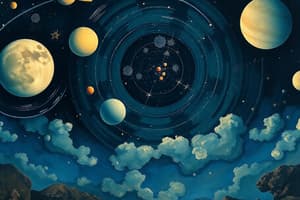Podcast
Questions and Answers
Which type of planets are Mercury, Venus, Earth, and Mars in our solar system?
Which type of planets are Mercury, Venus, Earth, and Mars in our solar system?
- Terrestrial planets (correct)
- Dwarf planets
- Gas giants
- Ice giants
Which pair of planets in our solar system have landscapes that vary between searing deserts and verdant continents?
Which pair of planets in our solar system have landscapes that vary between searing deserts and verdant continents?
- Jupiter and Saturn
- Mars and Mercury
- Uranus and Neptune
- Venus and Earth (correct)
Among the gas giants in our solar system, which two planets exhibit stunning equators enveloped in bands of vivid colors?
Among the gas giants in our solar system, which two planets exhibit stunning equators enveloped in bands of vivid colors?
- Jupiter and Uranus
- Uranus and Neptune
- Saturn and Neptune
- Jupiter and Saturn (correct)
Which two planets in our solar system possess no moons?
Which two planets in our solar system possess no moons?
Which moons captivate researchers due to their potential habitability beneath their icy facades?
Which moons captivate researchers due to their potential habitability beneath their icy facades?
What is Pluto commonly mislabeled as?
What is Pluto commonly mislabeled as?
During the Big Bang and subsequent formation stages, which of the following were involved in the creation of celestial bodies?
During the Big Bang and subsequent formation stages, which of the following were involved in the creation of celestial bodies?
What type of celestial bodies are primarily fostered in the hot inner zones of protoplanetary discs?
What type of celestial bodies are primarily fostered in the hot inner zones of protoplanetary discs?
Which mission aims to explore Jupiter's trojan asteroids?
Which mission aims to explore Jupiter's trojan asteroids?
What molds planetary shapes and the distribution of smaller bodies like meteors and comets?
What molds planetary shapes and the distribution of smaller bodies like meteors and comets?
Flashcards are hidden until you start studying
Study Notes
Discovering the Wonders of Planets and Moons within Our Cosmic Backyard
Beyond the glowing sphere of fire we call the Sun, the celestial dance of our solar system unfolds, graced with eight distinct planets and myriad enchanting moons. Each world holds unique stories of formation, evolution, and possible habitable realms worthy of exploration. Let's embark upon this journey through our local cosmos.
The Solar Neighborhood's Titans
At the heart of our solar system reside the four terrestrial planets —Mercury, Venus, Earth, and Mars. Constructed primarily of silicate minerals and metals, their landscapes vary between searing deserts to verdant continents teetering on the precipice of life.
On the opposite side of the spectrum dwell the gas and ice giants—Jupiter, Saturn, Uranus, and Neptune. Their grandeur stems from the abundance of hydrogen, helium, methane, and various ices. Jupiter and Saturn particularly exhibit stunning equators enveloped in bands of vivid colors while Uranus and Neptune present themselves as a slate blue marbled canvas.
Luna Companions
While Mercury and Venus possess no moons, the remainder of our planets delight in their lunatic companions. The largest collection belongs to Jupiter and Saturn, whose families number over 100 moons apiece. Notably, Ganymede, Callisto, Io, and Europa captivate researchers due to their potential habitability beneath their icy facades. Smaller moons even resemble minuscule solar systems.
Pluto, often mislabeled as a dwarf planet, keeps company with five delicate moonlets, including the picturesque Charon. Such orbs are commonplace amongst asteroids, while even tinier celestials like 3122 Florence harbor unexpectedly miniature siblings.
Genesis and Evolution: From Chaotic Nurture to Orderly Habitats
Clusterings of the solar system reflect their origins during the Big Bang and subsequent formation stages involving protostars, comets, asteroids, and protoplanets. As the solar nebula spun, protoplanetary discs emerged, allowing hot inner zones to foster rocky bodies while colder outer regions permitted the growth of icy giants. Cataclysmic impacts molded planetary shapes as well as the distribution of smaller bodies such as meteors and comets.
Continuing Quests for Answers
As humanity continues to gaze upward, visiting robots continue to expand our collective understanding of the solar system's treasures. The Lucy Mission explores Jupiter's trojan asteroids, while the MMX Mission aims to unravel mysteries surrounding Mars' moons. Whether examining ancient fragments or navigating vast expanses, every discovery adds to the tapestry of wisdom underpinning our celestial neighbors.
Studying That Suits You
Use AI to generate personalized quizzes and flashcards to suit your learning preferences.



